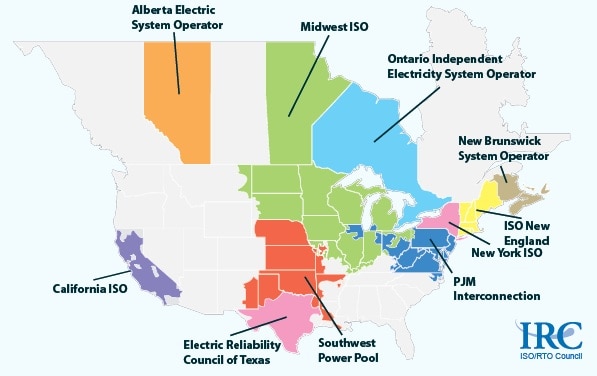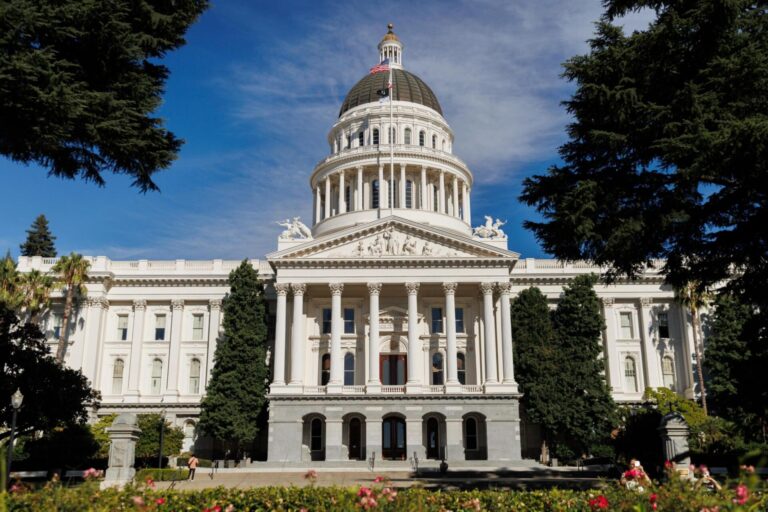How to Secure the Grid and Save Ratepayers Money

Background: The Aging Power Grid
Knowing of how the electrical system works is critical to understanding why and how solar energy benefits the power grid. The U.S. electric grid consists of large high-power voltage lines, substations, and transformers, all of which are linked together and transport electricity from power plants to homes and businesses. After electricity is generated at a power plant, it is then sent to a step-up transmission substation where the electricity increases in voltage in order move along high-voltage transmission lines. However, before a customer uses electricity it must go through another substation and transformer to reduce the voltage for consumption in a home or business. In total, the electrical system in the United States includes 200,000 miles of transmission lines crisscrossing the country, approximately 2,000 electric distribution utilities, and 7,000 power plants, according to the U.S. Energy Information Administration.
Redundancy has been built into each of the grids allowing operators to find alternative paths for power in cases of emergencies, such as broken lines or even terrorist attacks. However, the figure below created by The Wall Street Journal illustrates how electricity generated in California, for example, could not get sent over the high-voltage power lines to New York. It is up to regional organizations to monitor, assess, and maintain appropriate power loads.
In reality, once a megawatt (MW) of electricity is generated by a power plant, it is bought and re-sold numerous times before being used by the consumer. These transactions form the wholesale electricity market. Wholesale markets are operated by regional transmission organizations (RTO) and independent system operators (ISO). The map below illustrates these organizations.
However, RTOs/ISOs are not the entities actually generating power. Electric utility companies operate within these territories and it is their business model that relies on selling power to generate revenue. Outside of the wholesale markets, the market is operated by vertically integrated utilities, which means the generation of electricity and the transmission system are owned by a single utility in a particular territory. Southern Company is an example of a vertically integrated utility. Southern Company acts like a monopoly since it constructs, acquires, owns, and manages generation assets and provides the electricity to four states in the Southeast.
And finally, the remaining consumers in the U.S., about 12 percent, are members of electric cooperatives. Electric co-ops are private, not-for-profit businesses governed by their customers and are located in rural areas where the return on expensive infrastructure investment was not high enough to attract investor-owned utilities. Cooperatives then formed to combine purchasing power in order to generate electricity or buy electricity from the investor-owned power plants. The electricity is then delivered over transmission lines, which are typically owned and maintained by these cooperatives.
The Threat of Our Aging Electrical Grid
All of the parties involved with the U.S. power grid, including the Federal Energy Regulatory Commission (FERC), the federal agency with jurisdiction over interstate electricity sales, want to make sure electricity is reliable, and the grid itself secure. But, reliability is becoming a challenge as the existing infrastructure ages. About 70 percent of power lines and transformers are over 25 years old, 60 percent of circuit breakers are more than 30 years old, and some parts of the grid are over 100 years old.
In addition to an aging electrical grid, additional stress is added to the grid due to climate change making storms stronger and summers hotter, and the constant threats of cyber or physical attacks. This is why the 2013 report card by the American Society of Civil Engineers (ASCE) rated America’s energy infrastructure, including the power grid, a “D+”. The utility industry will need to spend billions of dollars to update the grid and keep it secure.
ASCE also writes that looking ahead in the 21st century, the U.S. will need to adopt technologies to manage congestion points while investing in more transmission grid infrastructure. Solar energy can and should play a significant part in this process since it can decrease congestion and even save money from being spent on building more transmission lines and power plants.
Solar Power Makes The Electrical Grid Secure
In April 2013 at a Bloomberg New Energy Finance Summit, then FERC Chairman Jon Wellinghoff said, “It wouldn’t take much to take the bulk of the power system down. If you took down the transformers and the substations so they’re out permanently, we could be out for a long, long time.”
Wellinghoff was speaking a week after a mysterious rifle attack occurred near San Jose, California at a Pacific Gas and Electric Co. (PG&E) substation. The attack damaged 17 transformers, and caused $15 million in damages while creating fear in the utility industry because the attack almost caused a blackout. PG&E has since committed to spend $100 million over the next three years to bolster the security of its facilities. Wellinghoff called the attack “the most significant incident of domestic terrorism involving the U.S. power grid that has ever occurred.”
Furthermore, The Wall Street Journal recently reported on an alarming FERC study conducted in the aftermath of the attack that found a small number of the country’s substations play an outsize role in keeping power flowing across large regions. An attack damaging just nine of these substations could cause the entire country to lose power for weeks, if not months.
The national power grid is aging and vulnerable to attacks, but the electric utility industry and regulators can fix both problems by deploying more distributed solar energy.
Indeed, Wellinghoff went on to say at the Bloomberg event that one way to protect the power grid is to have more distributed systems throughout the country since “millions of distributed generators can’t be taken down at once.” In other words, by deploying rooftop solar throughout the country, utilities (such as PG&E) and RTO/ISOs (such as PJM Interconnection) can secure the grid and help consumers avoid blackouts (from terrorism or natural disasters).
The integration of distributed energy systems will also protect the economy. A report from the White House Council of Economic Advisers and Energy Department found that weather-related outages between 2003 and 2012 cost the economy an inflation-adjusted annual average of $18 billion to $33 billion.
However, the transition to a smarter and more secure grid with more solar energy will not happen overnight. Regulators must position utility companies in a forward-looking direction and embrace policies such as net metering to continue incentivizing the use of solar. Deploying additional solar will protect the aging grid by reducing the need to build more power plants and transmission lines, and preventing transmission congestion.
Solar Power Reduces Transmission-Line Congestion
Transmission-line congestion occurs on the power grid when the flow of electricity over a transmission line is constrained either because of high demand or because of downed power-lines. Solar power is a valuable addition to the grid because it reduces transmission-line congestion by avoiding the construction of new centralized power plants, which then require the use of transmission lines to reach consumers.
Transmission-line congestion also financially impacts utilities’ pocketbooks. The North Carolina Utilities Commission commissioned a 2013 study for Dominion North Carolina Power and determined, that in the years 2011-2012, transmission congestion cost Dominion nearly $7 million.
Utilities can take into account the benefits of distributed solar through congestion pricing, which monetizes the benefits of reducing transmission constraints. Distributed solar can put the power generation right where it’s needed thus reducing transmission congestion.
A 2013 study commissioned by Vote Solar and undertaken by Crossborder Energy, using a Colorado Public Utilities Commission approved methodology, found that the financial benefits of net metered power outweigh the costs, with a total net value between $7 and $11 million per year in Xcel Energy’s Colorado territory. Among the benefits are the savings from having to build more transmission lines.
Furthermore, a 2012 study examined Pennsylvania and New Jersey, which are in the PJM Interconnection territory, and concluded that solar PV not only displaces the capital costs utilities would have to pay (and eventually pass onto customers) but also defers the need for transmission and distribution infrastructure because:
“[L]ocal loads continue to grow and eventually necessitate the transmission and distribution capital investment. Therefore, the cost savings by distributed PV is merely the cost of capital saved in the intervening period between PV installation and the time at which loads again reach the level of effective PV capacity.”
In other words, solar generation delivers effective capacity that can reduce the risk of power outages that are caused by high demand and stressed areas of the transmission and distribution systems.
Conclusion
The complex U.S. power grid involves many different entities, from power plants to grid operators, all working 24/7 to provide electricity. But our nation’s power grid is old, centralized and, as a result of its current configuration, vulnerable to blackouts from attacks or natural disasters. The grid is also stressed by congestion. Solar energy provides a solution to these challenges by allowing utility companies to avoid building more large-scale power plants (which are paid for by ratepayers). Utility companies should recognize that solar increases grid security by putting power generation close to demand (where it’s needed), decreasing transmission congestion, reducing line loss, and lessening our dependence on purchased fuel (coal and natural gas). Utilities and the regulatory commissions can increase grid security by incorporating more solar power. Regulators should recognize the benefits of distributed solar energy generation and work to strengthen or expand net metering policies that support the growth of distributed solar systems.
Read Part One: Wall Street and Regulators Choose Solar Over Fossil Fuels
Read Part Two: The External Costs of Fossil Fuels; Environmental and Health Value of Solar
This page is part of EPI’s series, “Value of Solar Versus Fossil Fuels” published in August 2014.



